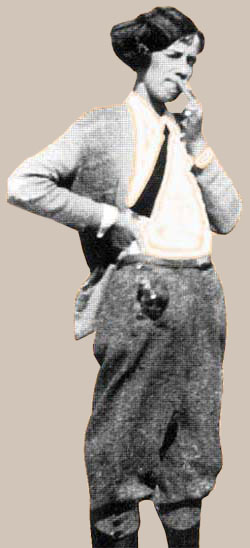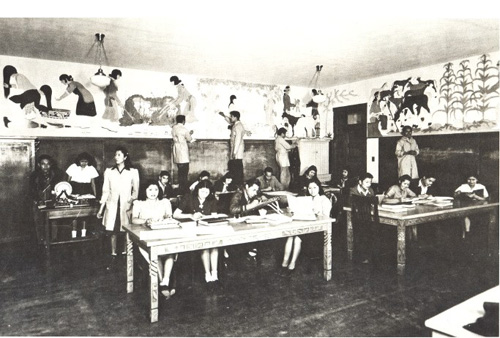Paintings by Early Students of the Santa Fe Indian School
August 08, 2016 until October 16, 2016
Show Extended - by popular demand!
The Santa Fe Indian School’s art department was created in 1932 by Kansas-born, Chicago-educated artist Dorothy Dunn. Dunn first discovered Native American art at Chicago’s Field Museum in 1925, and eventually moved to New Mexico to teach grade school. In 1931, while back in Chicago completing her degree, she outlined and submitted a proposal to begin teaching art at the Santa Fe Indian School. Her proposal was accepted, and on September 9, 1932, The Studio opened its doors. Native artists Alfonso Roybal and Julian Martinez created murals to welcome and inspire The Studio’s young students.
 Dunn strove to create an atmosphere of genuine creative expression, encouraging her students to celebrate their unique cultural heritage and cultivate their natural talents. The style she taught—which eventually became known as The Studio Style—was heavily influenced by the San Ildefonso painters of the early 20th century, documenting and celebrating the rituals, ceremonies and mythology of her growing student body’s various Pueblo homes. Dunn’s adherence to a single style of painting has been criticized by some Native Americans as lacking in originality, but the success and influence of her students suggests that her training was very effective for these young artists. Gerónima Cruz Montoya (1915 - 2015) P'otsúnú - White Shell of San Juan Pueblo, who eventually replaced Dunn as The Studio’s director, praised Dunn for teaching her students to take pride in their often misunderstood cultures.
Dunn strove to create an atmosphere of genuine creative expression, encouraging her students to celebrate their unique cultural heritage and cultivate their natural talents. The style she taught—which eventually became known as The Studio Style—was heavily influenced by the San Ildefonso painters of the early 20th century, documenting and celebrating the rituals, ceremonies and mythology of her growing student body’s various Pueblo homes. Dunn’s adherence to a single style of painting has been criticized by some Native Americans as lacking in originality, but the success and influence of her students suggests that her training was very effective for these young artists. Gerónima Cruz Montoya (1915 - 2015) P'otsúnú - White Shell of San Juan Pueblo, who eventually replaced Dunn as The Studio’s director, praised Dunn for teaching her students to take pride in their often misunderstood cultures.
The Studio’s long list of notable alumni includes Quincy Tahoma, Pablita Velarde, Harrison Begay, Gerald Nailor, Blue Corn, Pop Chalee, Eva Mirabal, and Narciso Abeyta. These artists, and the generations of artists whose work they influenced, represent a truly vital part of New Mexico history. Adobe Gallery has always celebrated the work of these Santa Fe Indian School alumni, and is displaying this historically significant and distinctly Native American collection with great honor. Though Dunn and her students achieved a great deal of well-deserved notoriety for their two-dimensional or flat-style watercolor paintings, the movement actually had its beginnings around the turn of the century, 30 years before The Studioopened its doors. Esther Hoyt, a teacher at the San Ildefonso day school, encouraged her students to think of the pueblo dances and paint what they felt while experiencing them, even though it was against United States Government policy. Her early students were Tonita Peña, Awa Tsireh, Santana Roybal, Abel Sanchez, and Romando Vigil. It was from this school that the Indian easel art developed. The works of these painters, who became known as the “San Ildefonso self-taught” artists, are displayed alongside those of Dunn’s students. This exhibit represents the creation, evolution, and eventual perfection of an artistic movement that has been celebrated around the world.
Though Dunn and her students achieved a great deal of well-deserved notoriety for their two-dimensional or flat-style watercolor paintings, the movement actually had its beginnings around the turn of the century, 30 years before The Studioopened its doors. Esther Hoyt, a teacher at the San Ildefonso day school, encouraged her students to think of the pueblo dances and paint what they felt while experiencing them, even though it was against United States Government policy. Her early students were Tonita Peña, Awa Tsireh, Santana Roybal, Abel Sanchez, and Romando Vigil. It was from this school that the Indian easel art developed. The works of these painters, who became known as the “San Ildefonso self-taught” artists, are displayed alongside those of Dunn’s students. This exhibit represents the creation, evolution, and eventual perfection of an artistic movement that has been celebrated around the world.

